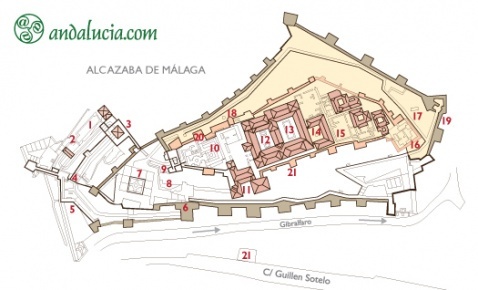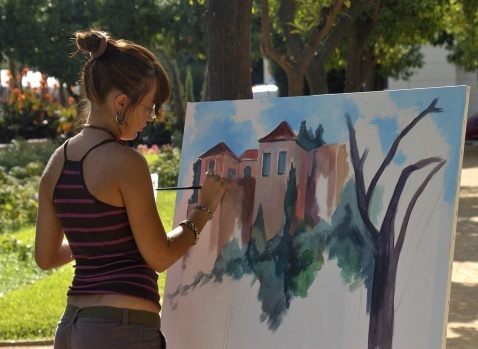
La Alcazaba is Malaga's most important landmark |
|
Alcazaba
La Alcazaba is Malaga's most important landmark, and overlooks the city from a hilltop inland. It is one of two Moorish fortresses in the city, the other being the Castillo de Gibralfaro, situated above. The Alcazaba is one of the best-preserved Moorish fortress palace in Spain.
Alcazaba and Nasrid Palace Private Walking Tour Tickets
Buy tickets for Alcazaba Guided Tour
History
Constructed on the ruins of a Roman fortification during the reign of Abd-al-Rahman I, the first Emir of Cordoba, in around 756-780AD, the Alcazaba's original purpose was as a defence against pirates, thanks its commanding position with views over the city, down to the sea and across to Africa.
The fortress was rebuilt by the Sultan of Granada, Badis Al-Ziri, from 1057-1063AD, while the fortified double walls that connect the Alcazaba to the neighbouring Castillo de Gibralfaro, over the Coracha ridge, were built by the Nasrid ruler Yusuf I in the 14th century, when most of the inner palace was also refurbished. As a palace, it was home to a number of Moorish rulers.
The Alcazaba has a distinct feel from its more famous, younger neighbours, the Alcazar of Sevilla and the Alhambra of Granada. It was already three centuries old when the others were build. After the reconquest, it fell into decay until restoration work began in 1933, and continues slowly today. Two of its original three walls remain, as well as over 100 towers and three palaces.
Key
1. Entrance
2. Way in
3. First Angled Gate - Puerta de la Bóveda (Gate of the Vault)
4. Puerta de las Columnas (Gate of the Columns)
5. Exit to the Haza de la Alcazaba
6. Second Angled Gate - Torre del Cristo (Christ's Gate)
7. Plaza de Armas
8. Silo
9. Puerta de los Cuartos de Granada (Gate of the Halls of Granada) leading to upper precinct
10. Silo, Garden and Patio de los Surtidores (Jets of Water)
11. Torre de Maldonado (Maldonado Tower) and Torre de la Armadura Mudéjar (Mudéjar Ceiling)
12. Patio de los Naranjos (Orange Trees)
13. Patio de la Alberca (Pool)
14. Patio del Aljibe (Reservoir)
15. 11th century dwellings
16. Torre del Homenaje (Homage Tower)
17. Well
18. Dungeons
19. Access to the Coracha and the Gibralfaro
20. Toilets
21. Access to lifts
What you can see today, and how to get there
The fortress's entrance area, which is close to the Plaza de Aduana and the Roman theatre in Calle Alcabazilla, forms part of the city walls. You pass through the Puerta de la Bóveda (Gate of the Vault), a typical Moorish puerta en recodo (a defensive castle entrance designed to delay the arrival of attackers - after entering through an arch, they come up against a blank wall, and have to make a sharp turn to gain access to the next part of the fortress). A little higher up, you pass through the Puerta de la Columnas (Gate of the Columns), which was built using Roman marble columns to hold up the Moorish horseshoe arches.
You then enter the lower precincts of the Alcazaba, via the second puerta en recodo under the Torre del Cristo (Christ's Tower). This was where the first mass was celebrated following the victory over the town by the Reyes Catolicos, and continued to be used as a chapel. The lower precinct follows the contours of the hill, and you can stop and rest at the Plaza de Armas, which is now a garden with fountains and a bastion on the south side which once defended the coast.
Follow the little cobbled paths through the Puerta de los Cuartos de Granada (Gate of the Halls of Granada, which lead into the upper precinct where the pathway passes through attractive landscaped gardens. Inside the Nazari palace, at the top of the fortress, you can explore three courtyards: the Patio de los Surtidores (Courtyard of the Fountains), which features a row of caliphal arches leading to the Torre de la Armadura Mudéjar (Mudejar Armoury Tower) with its 16th-century carved wooden ceiling. The Torre de Maldonaldo (Maldonado Tower), with its original marble columns and balconies, offers the best views so far.
The next two courtyards in the palace are the Patio de los Naranjos (Courtyard of the Orange Trees) and the Patio de la Alberca (Courtyard of the Pool). The palace is quite extensive with arches, towers, gates, and original marble columns.
Some areas, such as the dungeons and the Patio del Aljibe (Courtyard of the Reservoir), and the Torre del Homenaje (Homage Tower) and original Moorish dwellings, mosque and baths are closed for restoration.
There is a small archaeological museum, exhibiting fragments of Roman pottery and statues of various sites around the province, including Lacipo (Casares) and Villa de Rio Verde, (Marbella). You can also see Moorish ceramics and other artefacts found on the site.
To return to the city, you can either return by the same route, or take the elevator from the Nazari Palace down to the (secret) street level entrance on Calle Guillen Sotelo (opposite Calle Francisco Bejarano Robles). The mobility-challenged, elderly, less energetic or time-pressed visitor may prefer this as their entrance route.
Gibralfaro Visit
Unfortunately there is still no direct walking route between the Alcazaba and its neighbouring fortress situated further up the hill, the Gibralfaro, over the Coracha ridge of land which joins the two castles. From Plaza Aduana take Calle Juan Temboury and follow the path up the hill. Allow a good 40 mins and take water in the summer. There is a number 35 bus from oposite the town hall on the nearby Alamena
Opening hours
Summer: 09.00 hrs to 20.00 hrs (1st April to 31st October)
Winter: 09.00 hrs to 18.00 hrs (1st November to 31st March)
(last admission half an hour before closing)
Closed 1st Jan and 25th Dec.
Entrance fees
Normal: 3.50 euro
Joint ticket Alcazaba & Gibralfaro: 5.50 euro
Reduced (Malaga residents, children aged 6-16, students): 1.50 euro.
Audio guide 5 € euro
Free entry Sundays after 2pm.
Address
Calle Alcazabilla 2, 29012 Málaga
Tel: Office: 630 932 987 Switchboard: 952 227 230 / 957



